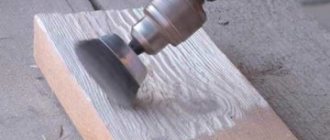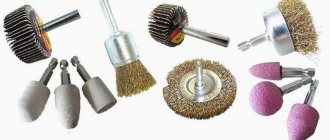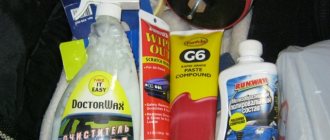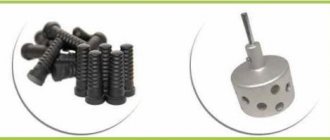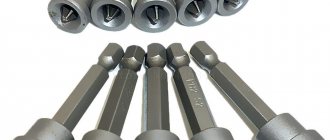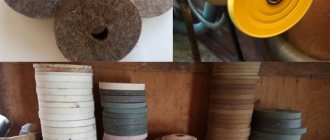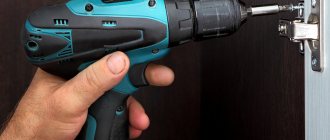Attachments for drills, screwdrivers and grinders for polishing cars - types and their choice
All car owners value their vehicle. Some even associate a car with their second home. All car enthusiasts are especially sensitive to the appearance and condition of the car. Even minor scratches and damage can ruin the mood of the car owner.
Why do you need to polish a car body?
But how can you make your car look more attractive and presentable? One way to maintain a presentable form of transport is by polishing. Polishing removes scratches, small chips and other subtle defects. The basic concept of polishing is that car mechanics remove a thin layer of paintwork. This allows you to get rid of scratches and chips, as well as return the car to a fresh, presentable look without damaging the paintwork.
Let's sum it up
There are many modern materials for performing complex restoration and protective work on a car. You can treat the body parts in advance to prevent scratches. After damage to the body, you will have to restore the coating and remove the damage. You can perform the necessary procedures using a drill. But all work must be carried out carefully and only after gaining certain experience.
With such a tool at high speeds you can easily burn the paint on the body, which will require repainting in the future. All you have to do is watch the video and determine if your power tool has the necessary settings. If such opportunities exist, you can save money without difficulty. But another important condition will be the purchase of good consumables.
Types of polishing work
Restorative polishing is divided into soft and deep. They differ only in the degree of varnish removal. Soft polishing removes a relatively small layer of paintwork. This is enough to hide the “spider web” effect or save the car from minor scratches. For deeper defects, it is better to use deep polishing, which will cope with scratches, small chips, etc.
Step-by-step instructions for the 3 main polishing methods
Sometimes the result of polishing may depend not on the effectiveness of the product itself, but on how the polish was applied. Therefore, it is important to adhere to the technology of performing work when cleaning lampshades using different means.
Preparation is practically independent of the chosen method. It includes cleaning the headlight from dirt, dust, and drying the surface. It is also worth considering that there are two polishing methods:
- Removable . The headlight is removed from the vehicle before processing. The method takes more time, but is more convenient.
- Non-removable . Body protection is important when using this method. All parts around the headlights are covered with paper tape.
Protective edging made of masking tape.
Using sanding and polishing
Sandpaper becomes the most effective method, with the exception of a sander, to help get rid of complex damage in the form of deep scratches. Polishing consists of 3 stages.
| Step 1. Sanding | It starts with sandpaper with the lowest grit (in advanced situations it’s worth starting with 600) and gradually moving to the highest one up to 2500. Processing with each sandpaper takes 2-3 minutes. After sanding with the coarsest grit sandpaper, the surface of the lampshade should become matte | |
| Step 2. Treatment with polishing paste | Depending on the material and degree of damage, polishing paste is selected. It carefully covers the surface of the lampshade; after treatment, scratches disappear, the headlight becomes transparent, not dull. | |
| Step 3. Final polishing | For this purpose, paper towels, microfiber cloths and other similar materials are used. The goal is to remove all remaining abrasive paste. |
The polishing procedure is completed. Additionally, the lampshades can be coated with a special varnish; it will create a protective layer, give the headlights shine, and increase their service life.
Using toothpaste
Another popular method, its advantages are low cost and ease of operation. Disadvantage - toothpaste will help eliminate only minor damage to the lampshades.
To work you will need:
- toothpaste (any will do);
- Toothbrush;
- warm water;
- clean rag;
- polish.
The work process is outlined in the following table.
| Step 1. Apply the paste | Toothpaste is applied to the cleaned headlight. The manual method uses a toothbrush or some other small brush; you can also use a grinder. Application of the composition is carried out in a circular motion with the application of significant force. | |
| Step 2: Cleaning | Use warm water to rinse off all remaining toothpaste. After this, the surface of the lampshade is thoroughly wiped with a dry cloth. | |
| Step 3: Polishing | The final stage will be applying polish and treating the surface of the material with a dry cloth. |
The damage is usually external, but it can also be internal. To clean the inner surface, you will have to remove the lampshade.
We consolidate the information by watching the video.
Use of acetone vapor
Acetone is an effective remedy, but is used only for treating plastic surfaces; it is ineffective for glass headlights. You will need a special device that heats the acetone, on which a lid with an elongated spout is installed. You can make such a tool yourself; for this, craftsmen use a piece of shock absorber, a heating filter tape, a tube and connections with molten plastic. As an alternative, you can purchase a ready-made evaporator.
Acetone polishing kit.
There should be no sources of combustion, including cigarettes, in the room where polishing with acetone will be carried out. You need to work in a respirator and protective clothing.
The step instructions are described in the following table.
| Step 1. Acetone is poured into the heating device | The device is connected to the power supply. You need to wait until steam starts to come out of the tube | |
| Step 2. The plastic lampshade is treated with a jet of steam. | It is necessary that the device is located as close as possible to the headlight. It is important to “apply” the steam so that the treatment is uniform, without missing areas | |
| Step 3. After processing, leave the headlight for 10 minutes | It is important not to touch it with anything, because a cloudy spot will form at the point of contact. | |
| Step 4. Ventilation | After polishing is completed, the room must be ventilated for at least several hours so that all vapors escape. | |
Treatment with acetone vapor allows you to achieve a transparent effect. To consolidate the result, the headlights are additionally coated with a special varnish or protective film.
You can visually study the method using video.
Equipment types
Several types of equipment are used in polishing. Firstly, these are rotary polishers. They come in different types, sizes, capacities, etc. However, by and large, they are all the same. All modern rotary polishers have several speed levels and replaceable polishing plates. They constantly maintain the same speed, the nozzles rotate in a circle.
In addition, eccentric sanders can be found in auto repair shops. This type of grinder has several types. In fact, they differ only in the rotation of the disk.
This equipment is professional. If you decide to polish the car yourself, then a drill, screwdriver or grinder may be enough for you.
When polishing, what matters most is not so much the tool you use, but the polishing attachment and, of course, a certain skill in polishing.
Tips for choosing
In a good half of cases, grinding attachments are sold under the brand name of electrical equipment manufacturers. It's good if both devices are of the same brand. Then there shouldn't be any compatibility problems.
It is better to look towards well-known brands. They care about quality due to high competition in the market. Although products from no-name manufacturers are much cheaper, the chance of running into a mediocre product in this case is much higher.
Popular manufacturers:
- "Bosch"
- "Makita";
- Dremel
- "Bison";
- "Matrix";
- Fit;
- "Enkor";
- Verto.
It makes more sense to overpay for quality than to constantly buy waste grinding attachments that wear off after several uses.
Types of polishing attachments
After we have understood the theoretical part a little, we should move on to the next point, which will help us figure out what type of polishing attachments to use and when.
It is worth noting that each detailing center has its own approach and, as a result, its own preferences in polishing attachments. The universal pattern by which you should polish your car must be created by you yourself, based on your personal preferences.
Polishing attachments are divided into groups according to several principles.
They are divided by appearance: surface grinding and flap grinding. And also according to the degree of hardness:
- With a relief surface;
- Medium hardness;
- With high rigidity.
Finally, they are divided according to the type of materials from which they were made. Below we will look at polishing discs made from different materials, their pros and cons, and also help car enthusiasts decide on the choice of attachment to polish their car at home.
Felt or felt car polishing supplies
Felt or felt polishing discs are often used to process metal body surfaces. Felt polishing discs come in three types and are divided according to the thickness of the wool - thick, medium and fine. The choice of wheel depends on the type of work being carried out, so it is important to select the required disk when processing metal. The least common are discs with fine wool. They are used either for surface cleaning or during polishing of non-ferrous metals. Felt discs with medium and thick wool are used more often. Medium wool thickness is preferable for minor repair work - barely noticeable cracks, small chips, etc. Thick-haired discs are used for deep paintwork processing to remove large scratches.
Sheepskin nozzle for car polishing and its types
Sheepskin wool discs are one of the most common. This is due to both ease of operation and relative low cost compared to analogues. The average person may have the opinion that since the wool is soft, then logically such an attachment should be used in the final stages. However, this does not entirely fit current realities. Some wool discs may leave marks after processing the body, so it is important to choose and take a disc that will suit the type of work you are doing. Also, it should be noted that all wool discs lose the quality of their work if used incorrectly. Pay attention to the required disk rotation speed to avoid unwanted incidents.
Sheepskin attachments for different types of polishing
Let's look at the types of disks and the types of work for which they are used. When polishing, three types of sheepskin discs are often used:
- Twisted pile. Such discs are used for rough processing. Thanks to their properties, twisted pile discs can easily cope with medium-depth scratches and similar defects of the same level of complexity.
- Classic sheepskin discs. Such discs are used at the final stages of car polishing. They are best suited for achieving a high-gloss shine on your car.
- Sheepskin for soft polishing. Such discs are characterized by the most delicate degree of processing. They are used at the final stages of polishing work. Such discs are quite expensive and also have a characteristic yellow coat color.
Advantages and disadvantages of sheepskin polishing discs.
Pros:
- They can easily cope with almost all scratches.
- Low consumption of polishing paste, which increases efficiency in use.
- They do not heat the surface of the body and, as a result, reduce the possibility of incidents and unforeseen situations.
Minuses:
- Cannot be used at the final stage, since such discs leave holograms and small scratches.
- The price of some discs may be higher than that of similar discs made from other materials.
- Should only be used at certain speeds.
Foam polishing attachments types and purposes
Foam polishing attachments, like previous discs, are divided into several types, which are used for certain operations. They are divided into three types:
- Soft. Used at the final stages of polishing work. Thanks to their structure, they can easily cope with the last cleaning of the body.
- Average. They are used by auto repairmen to polish the body and also hide minor defects.
- Tough. During polishing, they are used to remove more noticeable defects: scratches, chips, abrasions, etc.
For the most part, foam discs are used to apply protective and restorative polish. They differ not only in rigidity, the types of which we examined earlier, but also in the shape of the base. You can find two types of such disks:
- With a corrugated base - petal. This type of disc is suitable for soft processing of paintwork. This is due to the fact that such discs have a smaller plane of contact with the surface, which allows for more delicate polishing of the body. This type is preferable when applying certain materials to the surface of the body, as well as when removing holograms. In addition, due to the smaller plane of contact with the surface of the car, it is possible to avoid strong heating of the body.
- Planar ones, in turn, are mostly used for standard polishing work.
Advantages and disadvantages of foam polishing discs.
Pros:
- Variability of choice;
- Cheapness.
Minuses:
- High consumption of polishing paste;
- During polishing, the body becomes very hot.
Fabric polishing pads
This type of attachment is mostly used for manual work of rubbing polishing paste into the paintwork.
Addition. Classification of varnishes
Varnishes are divided according to purpose, composition and labeling.
Purpose:
- For glass headlights;
- For polycarbonate;
- Protective and tinting varnishes.
Compound:
One-component. Most often these are acrylic varnishes, which have poor adhesion to plastic and are only suitable for glass surfaces.
Two-component. The varnish and hardener are in different containers and mixed immediately before application. Two-component varnishes dry very quickly, so they should be diluted in small portions.
Urethane. Dries quickly and protects well. An aerosol version is suitable for headlights.
Ceramic. A relatively new class of varnishes with increased scratch resistance. Heating a surface treated with this varnish causes scratches to heal.
There are many other types of varnish (cellulose, glypthal, metallized), but for various reasons they are not suitable for protecting headlights.
Marking:
LS (low solid). They are the most liquid in composition, are highly fluid, are not suitable for vertical surfaces and are not used in the automotive sector.
MS (medium solid). Medium fluidity, applied in several layers, with the obligatory drying of each.
HS (high solid). High content of solid components in the composition and a minimum of volatiles (solvents). Due to this, they are more environmentally friendly and quick-drying.
UHS (ultra high solid). Modern varnishes are applied in one layer and are resistant to damage. Requires high temperature drying.
How to choose a car polishing attachment
We figured out what kind of polishing attachments there are in principle. Now it’s worth summing up and deciding which attachments you should buy for polishing your car at home.
Much depends, of course, on what type of polishing work you plan to carry out. If we are talking about soft polishing, then the nozzles should have a more delicate effect. In the case of deep polishing, it is necessary to use coarser polishing discs. In addition, do not forget that special discs are needed for different types of surfaces. There are no universal discs that are suitable for everything, so it is better to buy several attachments separately that will satisfy all your needs.
Each auto mechanic has his own personal set of discs that he uses in his work. There is no generally accepted set, so everything is determined by trial and error.
However, there are a number of things to consider when purchasing polishing pads.
First of all, you need to pay attention to the rotation speed at which the disks work more efficiently. Manufacturers often indicate this speed directly on the polishing discs. Remember, when working at the wrong speed, the likelihood of damaging the surface of the body increases.
In addition, pay attention to the types of mounting so that the disc will definitely fit your tool and the size of the disc. With a smaller disk size, the convenience of work increases, but the area to be processed decreases, which is why the work time increases. The situation is the opposite when working with a large disk - it is more difficult to process paintwork with it, but the speed of work increases.
And of course you should pay attention to the manufacturer and price. It is better to buy discs from trusted brands. If you choose equipment from little-known or unverified manufacturers, there is a high probability that you will get a defective product that will ruin your paintwork. Don't take risks and buy a nozzle from a reputable manufacturer.
Video description
How to sand a wooden surface is shown in the video:
When working, it is important to correctly hold the sanding attachment on a wood drill relative to the surface. For example, if the plate attachment is not positioned at a right angle, its edges will easily damage the surface. To understand the principle of operation, it is worth practicing holding the tool correctly in advance.
There are 2 options for grinding with a drill:
- The worker holds a drill in his hands and works like an ordinary tool. This is a simpler and more familiar method, but it has disadvantages. Holding a drill for a long time can be tiring. In addition, it is important to monitor its position and not tilt it. Large surfaces are sanded in this way: walls, floors, ceilings, large furniture, cars.
- The drill is fixed motionless on the table, and the object is brought to it. This method can achieve high quality grinding, but it can only be used on small objects that can be held in your hands.
conclusions
Now that you have figured out how to choose the right car polishing attachments, you can easily carry out your first polishing work. Always remember that this type of work requires a delicate approach. It’s better not to take unnecessary risks and test the nozzle on another surface before use. So, by trial and error, you can create your own list of attachments that you will use in your work. Decide which material is preferable for you: foam rubber, sheepskin wool or felt. And always be mindful of the speed at which you polish the car.
However, to avoid mistakes that could have a negative impact on the condition of your car, it is better to give preference to professional detailing. Experts will quickly select equipment specifically for your case and return your car to its salon appearance without risk.
Individual protection means
The method of surface treatment described above is fraught with huge troubles. When working with nozzles made of steel wire or abrasive material, you should never forget to protect your eyes, face, and hands. Always use masks, goggles, and gloves. Wear a respirator during dusty work.
| Attention Bearing Buyers Dear customers, send your questions and requests for the purchase of bearings and components by email or call now: Delivery of bearings throughout the Russian Federation and abroad. Bearing catalog on the website |
Attention Bearing Buyers
Dear customers, send your questions and requests for the purchase of bearings and components by email or call now: +7 [email protected] Delivery of bearings in the Russian Federation and abroad. Bearing catalog on the website
themechanic.ru


